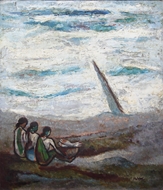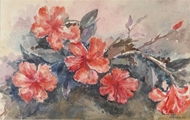![]() Significant Indian Paintings
Significant Indian Paintings
![]() Significant Indian Paintings
K K HEBBAR (1911 - 1996)
Significant Indian Paintings
K K HEBBAR (1911 - 1996)
RELATED LOTS
CONTACT US
Catalogue & Viewing
Lot Closed
Accounts & Shipping
Lot Closed
-
Literature
 Literature
Literature

Hebbar was born in 1912 in the land of Yakshgana in Canara. His initial academic training was at J J School of Art, Bombay. Later, as a student at the Academy of Julian at Paris, he was highly inspired by the vocabulary of Modern art where line and form transforms into a pictorial language which was acceptable toHebbar’s Indian traditional sensibility. He was influenced by masters like Matisse and Braque and like them freed his paintings from unnecessary shading. Later he used the coloured gradation from dark to light to obtain shade gradations. His lines have an expressive regularity. There is an intensity of emotion in his work since he felt strong ties with his subject.
He was not satisfied by painting for the sake of just making a statement but rendered it with personal intensity. He sympathized with the humble workers and depicted them with a sense of respect in his works. His works compel the viewer to give the same regard. He would often paint fisher- folk, construction workers, field help, fruit sellers, etc. His figures looked oblivious to the attention that they were getting. He believed in telling the truth and showed his subject in a natural manner instead of contrived posing. He captured what the eye saw. Though a lover of non-realistic form, he was not an abstractionist. Hebbar himself explained his technique saying, "I would achieve texture by the forceful application of colour with a palette knife. The under-paint method proved useful to achieve vibration in colour”.
It is a statement of his Indian aesthetics space in a contemporary idiom. There is a rhythmic movement imparting a breath of life. The strokes of impasto give a play of light and shade.Hebbar in his unique style renders an additional dimension to the work with his brush stroke. The winnowing of the crop adds movement to the entire composition and the figure unites the entire composition instantly.


